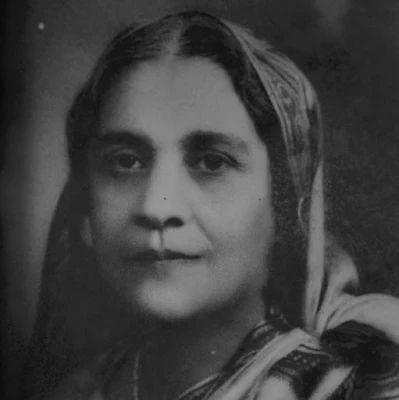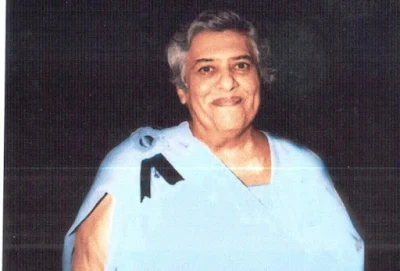DurgabaKamat remains the very first cinema actress in India.
Back when Dadasaheb Phalke first made Raja Harishchandra, he had to use male actors. But the success of the film gave rise to more people aspiring to work in the industry. Which is how Durgabai was first cast in Mohini Bhamasur. i Kamat
Fearless Nadia
The first stuntwoman of India, Nadia was uniquely talented and unafraid of more action-driven roles which eventually led to her long-lasting career.
Originally named Mary Ann Evans, she made her mark after headlining in the film Hunterwali. Nadia’s career went well into her 50’s and she was a defining female lead throughout the 30s and 40s.
Saraswati Devi
Born to a Parsi family with a love for music, Saraswati Devi was trained in Hindustani classical music before joining Marris College to study music.
She and her sisters gave regular performances at the All India Radio station in Mumbai which is how she was discovered by the founder of Bombay Talkies. She first composed music for the film Jawani Ki Hawa. Originally named Khorshed Homji, she took on the identity of Saraswati Devi because the Parsi community protested to have their women removed from the film business.
Usha Khanna
One of the most commercially successful music directors of her time, Khanna was a sensation throughout the 60’s, 70’s and 80’s. Some of her best-known songs include“Chhodo kal ki baatein” as well as “Zindagi pyaar ka geet hain”.
Her father was introduced to the industry when they first moved to Mumbai. She consequently sang a song for Sashadar Mukherjee, who was so impressed with her voice and compositional skills, he hired her to write two songs a day for a year, eventually making her the music director for the film Dil Deke Dekho.
She was also known to give upcoming singers a shot, these included names like Pankaj Udhas and Sonu Nigam.
Honey Irani
A child actor at the beginning of her career, Honey Irani featured on around 72 films. Reportedly, following her divorce from Javed Akhtar, she began to embroider sarees for a living.
But her career began when she narrated a short story to Pam Chopra for a TV series, which soon went on to become the film Aaina. After her debut as a screenwriter, she went on to pen some of the most memorable productions like Lamhe, Kaho Na…Pyaar Hai, Albela and Darr.
Constance Dass (1886-1971)
A woman with many firsts to her credit, Constance Dass was a double major in English Literature and Mathematics from Goucher College in the USA, the first woman topper in MA English from Allahabad University and the first Nationalist Principal of Isabella Thoburn College (I.T.) from 1939 to 1945. "During Dr Dass' tenure as the first Indian Principal of the I.T. (1939-45), she had the daunting task of steering the College during cataclysmic times: the impact of World War II, and the growing fervour of the Indian National Movement," Amrita Dass writes. "Under her leadership the college emerged as a citadel of the freedom movement."
Attia Hosain (1913-1998)
Born in a land-holding taluqdar family, Hosain was one of the first Indian girls to be admitted into the La Martiniere School for Girls which until then only took British girls. She also studied at Isabella Thoburn College and become the first woman from a taluqdari family to graduate. Hosain went on to join the All India Progressive Writers' Association. "Writing was for Attia was a private space, not one she was able to project or share. Her love of literature and writing and her struggle to make her own decisions placed her at great odds with family and society," her daughter Shama Habibullah writes in the book. She moved to Bombay in the 1940s, but took British nationality after 1947, a decision that her daughter says enabled her to travel freely between India and Pakistan. In 1961, she wrote her only novel, Sunlight on a Broken Column, an acclaimed book about a Muslim family in Lucknow of the 1930s.
Pratibha Nagar (1918-1990)
Soon after Independence, there was a legislation to abolish prostitution that affected the lives of the tawaifs of Lucknow and other cities. In 1953, social worker Pratibha, known as Baa, and her husband Amrit Lal Nagar, started an organisation called the Mahila Udyog Kendra specifically with the purpose of mending the lives of former tawaifs and their children, promoting education, and imparting vocational skills such as dressmaking and embroidery to these families.
Her other initiatives included the discarding of the chadar in Lucknow. She would frequently go door to door to collect money from the houses of the elite in the old city, to be spent on the wedding celebrations of girls from marginalised and deprived families.
"She always spoke honestly and boldly of everything under the sun. When older women tried to dissuade her, saying, 'Baa, you shouldn't talk of such matters when these young girls are around,' she would reply: 'One day they will have to face these realities, so they should be aware of everything,'" her granddaughters recall in the book.
Rasheed Jahan (1905-1952)
The path-breaking Urdu writer Rasheed Jahan was one of the leading figures of the Progressive Writers Movement. One of the first students admitted to the Women's College in Aligarh, she went on to work as a gynaecologist in government hospitals in several small towns in north India, and later joined the Communist Party. "Her writings centered around the lives of women whom she encountered as a doctor and who were far removed from the heroines of traditional Urdu literature. She wrote about their bodies, battered and aged by repeated and unwanted pregnancies; she wrote about the suffocation that they felt because of the unthinking insensitivity of their spouses and their own lack of agency and she wrote about the embers of revolt hidden deep in the recesses of bruised minds," Subhashini Ali writes.
In 1934, along with Sajjad Zaheer and Ahmed Ali, she published a slim volume of short stories called, Angaarey. It was immediately considered to be incendiary and banned, with fatwas being issues against the three writers. Jahan went on to play an important role in drafting the Manifesto of the Progressive Writers Association, founded in 1936.
Shivani (1923-2003)
One of the most popular Hindi magazine story-writers of the 20th century, Shivani's real name was Gaura Pant. Born in Rajkot, she spent 12 years studying in Shaniketan under Rabindranath Tagore, and went on to live in Nainital, Allahabad and Lucknow with her family. Her novels and short stories are set in her native Kumaon and have strong heroines. Her most-loved works include Krishnakali, Chaudah Phere, Apradhini, Yatriki and her two-part memoir, Smriti Kalash and Sone De.
"The word compromise had no place in Shivani's vocabulary — she lived on her terms, and when she could no longer do so, she preferred to die rather than become an appendage to someone else's life," Shivani's daughter Ira Pande writes. "To her, writing was something she loved to do — she never cared whether she won plaudits from critics, she was happy to scribble whenever a story came to her."
Gulab Bai (1919-1996)
Born in a Bedia family, Gulab Bai was reputed to be the first woman to enter the world of nautanki theatre. A natural singer, she learnt music, dialogue, acting, and rose to become the heroine of countless dramas, travelling in villages and cities for performances. "I heard Gulab Bai sing fifty years ago. She sang so beautifully, one could not stop listening," a younger fellow artiste, Chandrika Prasad Nidar recalls in the book. She was awarded a Padma Shri for her contributions to the nautanki form and a Sahitya Akademi for thumri singing. Having entered a form hitherto proscribed to women, she helped expand the spaces women could move into. In the 1950s, she set up the Great Gulab Theatre Company, which is now run by her daughter, Madhu.
Dr. Engineer (1915-1989)
Dr. Amy Dhunjibhoy Engineer was a leading gynaecologist and obstetrician in Lucknow. Known simply as Dr Engineer, she headed the Department of Obstetrics & Gynaecology at Queen Mary's Hospital (KGMC) from 1953 to 1976, when she expanded the facilities for the care of women patients and ensured the safe birth of babies. She also served as general physician to poor patients whom she saw at home without charging a fee, and remained Emeritus Professor at KGMC until her death in 1989.
Ismat Chughtai (1915-1991)
One of the foremost Urdu writers of the 20th century, Ismat Chughtai is known for her iconoclastic, feminist writings which explored the inner workings of women's lives and consistently challenged orthodoxy. Besides numerous short stories, plays, essays and novels, Chughtai also wrote and produced films, and was an active member of the Progressive Writers' Association.
In 1942, a case of obscenity was filed against her for the story Lihaaf in Lahore. She refused to apologise even though her husband and family advised her to do so and fought the charges, which finally ended in her being exonerated.
"The woman of Ismat's writings is both simple and a rebel, innocent yet daring. Her acts, her thoughts and her courage were highlighted in Ismat's writings. Whether it was Shanta of Ziddi, the Begum Sahiba of Masooma, Abida of Jungli Kabtoor, or the Baandi of Gori Biwiall, these were characters who chose the difficult options of life rather than the easy, straight path. Ismat's woman was a woman of the new world," Urdu writer Sabiha Anwar writes. "Ismat's woman was not afraid of circumstances, nor was she one to cower before her problems. With courage she found her own way in life."
Captain Lakshmi Sahgal (1914-2012)
As a doctor, an officer of the Indian National Army, and later an elected Member of Parliament, Captain Lakshmi Sahgal wore many hats. Born in 1914, she grew up in an atmosphere of nationalist politics. By 1940, she was a qualified gynaecologist, soon following a senior colleague to Singapore where she offered her medical help to the Indian National Army. In 1943, she met Subhash Chandra Bose and became the leader of the all-woman Rani of Jhansi regiment.
In 1971, she joined the CPI (M) and represented the party in the Rajya Sabha. "She became a popular fighter for many causes, from the Bhopal Gas victims, to victims of communal violence. The anti-Sikh carnage of l984 saw her standing in front of her clinic, chappal in hand, daring rioters to kill or burn any of the Sikh families in the area," her daughter Subhashini Ali writes. "She became a spirited leader of working class movements of textile and jute workers. She came to the forefront of the women's movement of the country."
Nadira
Of of the most memorable vamps at a time when many actresses would have turned such roles down, Nadira was best known for embracing off-beat roles such as in Aan or Shree 420. She transitioned seamlessly to more mature roles like in Julie or Josh and was one of the highest paid actresses of her time.
She also came to attention as one of the earliest actresses in India to own a Rolls Royce.
She is reported to have gone to composer Naushad Ali’s door and implored him to let her audition, after which she was hired as a playback singer. She peaked in the 1940s as a singer and was eventually phased out by singers like Lata Mangeshkar.
At this point, she picked up acting and starred in Dilip Kumar’s Babul, here Nargis gave her the name Tun Tun to suit her comic timing.
Her filmography includes classics like Aar Paar, Pyaasa and Namak Halal.


















No comments:
Post a Comment